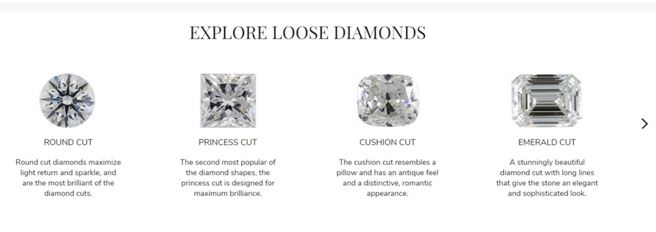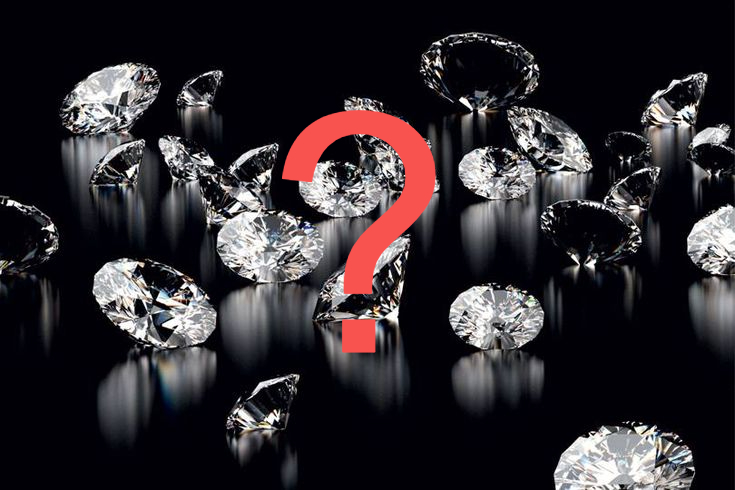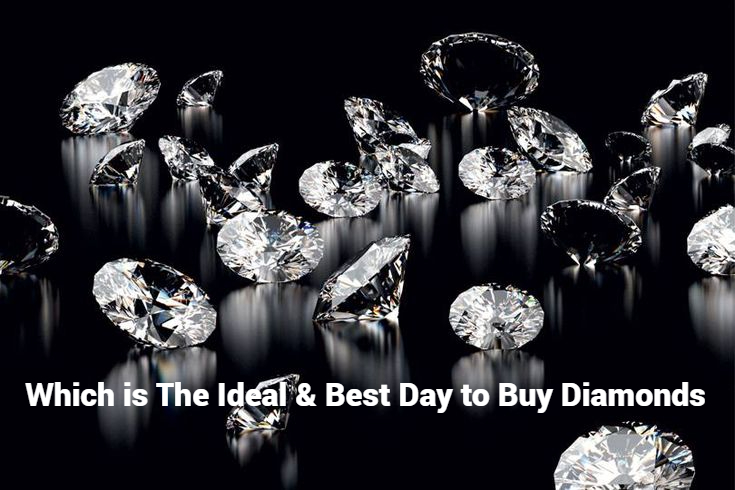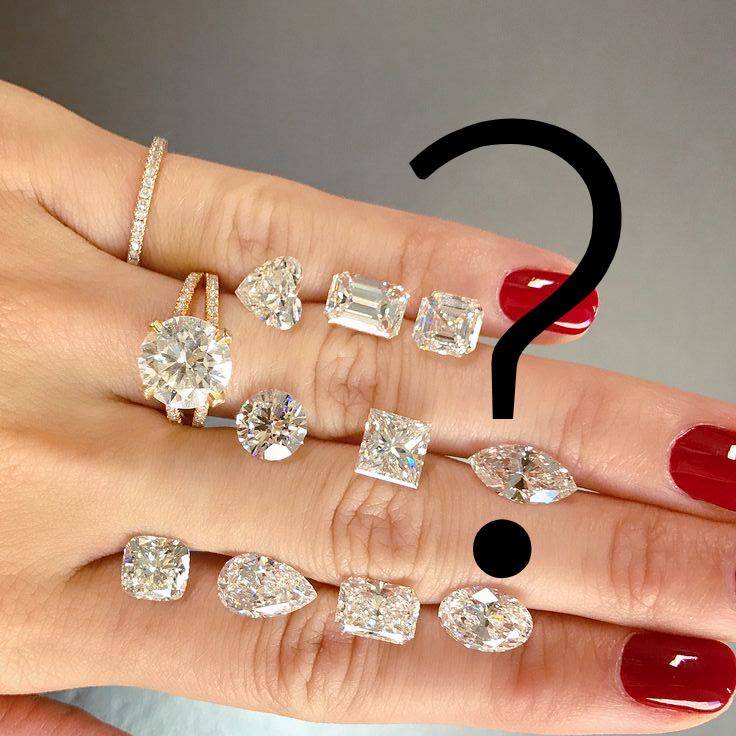Diamonds have always been valuable and desired, even if they were not always as shiny and polished as we have them today.
In this article, we would discuss the 4 characteristics of diamond quality in the following order:
- Introduction and History of the 4Cs of the Diamond
- The Cut: The interaction of the diamond with light. Some parameters to discuss include:
- Brilliance: Brightness emanating from the diamond
- Fire: The resultant effect of the diamond’s dispersion of light
- Scintillation: Refers to the sparkle seen when the diamond is moved
- Types of cut:
- Round brilliant
- Fancy cuts e.g pear shaped cut, Asscher cut, cushion cut, emerald cut
- Diamond proportions: refers to the relationship of the size, shape, angles, and facets with one another. It involves:
- The table
- The depth
- The pavilion
- The girdle
- The crown
- The culet
- The GIA grading system:
- Excellent
- Very good
- Good
- Fair
- Poor
- Color: Diamonds are not entirely colorless. The GIA grades them into:
- D – F (Colorless)
- G – J (Almost colorless)
- K – M (Faint)
- N – R (Very light)
- S –Z (Light)
- Factors that affect the color include:
- The setting of the diamond
- The mount
- Clarity: refers to the absence of impurities in the structure and surface of the diamond. Imperfections could be either external (blemishes) or internal (inclusions)
- Types of inclusions include feather, needle, crystal, pinpoint.
- GIA grading for clarity:
- Flawless (FL)
- Internally Flawless (IF)
- Very Very Slightly Included 1 and 2 (VVS1 and VVS2)
- Very Slightly Included 1 and 2 (VS1 and VS2
- Included 1, 2 and 3 (I1, I2, and I3):
- Carat: Refers to the weight of the diamond.
- It is different from the size
- Two diamonds can have the same weight but appear differently in size
- Larger diamonds cost more than smaller ones
- The carat alone should not be used to decide on what to buy
- GIA grading for clarity:
BRIEF HISTORY OF THE 4CS
In the past, there was no standardized metric of measurement and everyone just bought and sold diamond based on how they looked on the surface. This worked well but had a lot of limitations, one of which was that it was difficult to accurately access the characteristic of diamonds. Again, it was also very difficult to distinguish and classify diamonds.
This continued until 1953 when an organization – The Gemological Institute of America (GIA) introduced a standard by which all diamonds are graded and assessed.
The GIA was founded in 1931 and is recognized as a worldwide leader in issues pertaining to diamonds and diamond assessment. The GIA called this new standard the ‘4Cs of diamond quality’.
This brought a new wave of quality into the gem world as diamonds were now more objectively assessed. Just 2 years after this, they introduced the diamond grading report, which cemented their position as the leader in the assessment of diamonds.
The grading report gave adequate information about the properties of diamonds while also giving more insight into those properties.
In this article, we would be examining the 4Cs of diamond quality. We would highlight how each Characteristic contributes to the overall appearance and performance of the diamond.
The GIA described 4 characteristics of diamond quality namely:
- Cut
- Color
- Clarity
- Carat
We would now proceed to examine each of these qualities in detail.
THE CUT
Diamond cut is arguably the most important characteristic of diamond quality. This is because every other quality needs this particular characteristic to produce the desired quality. Among the 4Cs, the diamond cut is the only human factor. This is one of the things that makes it the most important.
In analyzing the diamond cut, we would examine the following parameters:
- Brilliance: Brilliance refers to the brightness that is exuded by the diamond as a result of reflections of light from the surface and the interior of the diamond. It is what makes the diamond appear bright when it is viewed.
- Fire: Fire is a resultant effect of the dispersion f light. Whenever light hits the surface of a diamond, it would split into its component colors. This effect is what is seen as fire when diamonds are viewed.
- Scintillation: Is the sparkle that is seen when a diamond is moved. This effect is formed as a result of the light and dark areas which are all products of the reflection of light.
At the center of all these effects is the cut. A well-cut diamond would reflect brilliantly and display a lot of fire and scintillation.
The cutting process involves carving out the dimensions of a proposed diamond from a rough diamond. It is very challenging for many diamond cutters. The reason is that they have to find a balance between an excellent cut process, which might mean a larger amount of rough diamond going to waste and cutting a larger diamond which would save more of the precious material.
Keep in mind that most customers that are not well informed would pay higher for a larger sub-optimally cut diamond than a small diamond even if it has a better cut. This has made some diamond cutters to sacrifice the quality of cut for carat, which is another characteristic that we would examine very soon.
However, a well cut diamond would always stand out, no matter the size. The degree of brilliance, fire, and scintillation observed in well cut diamonds cannot be compared.
This also brings to the fore the importance of the cut grade and the GIA grade reports, which help us to truly see a diamond for what it is.
TYPES OF CUT
- The Round brilliant cut which is the most popular today
- Fancy cuts which include the princess cuts, the Asscher cut, emerald cut and a host of other diamond cut into various shapes
DIAMOND PROPORTIONS
When we mention diamond proportions, we are discussing the relationship of the diamond’s size, shape, angles, and facets with each other. The proportions would determine how well a diamond would interact with light.
When light strikes a diamond surface, about 20% is reflected off the surface as glare. The remaining 80% passes into the diamond. Of the 80% entering the diamond, some would be also lost through the bottom of the diamond.
When a diamond is well cut, the facers are well positioned that they can refract and direct a large percentage of the light back to the eye of the viewer. This is what produces the brilliance, fire, and scintillation that is observed.
The following parameters are involved in discussing the proportions of the diamond:
- The table: This refers to the largest part of the diamond. It is the part through which light enters into the diamond. The table must be well cut to suit the desired cut and shape of the diamond. It must be wide enough to allow light to enter conveniently but not too wide so that light does not enter the crown and distort the appearance of the diamond when viewed.
- The depth: The depth of the diamond is the total measurement from the top to the bottom of the diamond. It is measured in millimeters but can be expressed in percentage by dividing the depth of the diamond by the width. The depth of the diamond would determine how far light has to go through before it is refracted and reflected. A diamond cut too shallow would leak a lot of light and have a poorer visual appearance while one that is cut too deep would appear smaller in size since the refracting surfaces are now farther from the light source.
- The pavilions refer to the refracting surfaces of the diamond. They must be well-positioned at the appropriate angles so that light would be well refracted to produce brilliance, fire, and scintillation.
- The crown: Just below the table.
- The girdle: The widest part of the diamond. It is also very thin and prone to chipping.
- Culet: This is the tip of the diamond, located at the bottom. It is the thinnest and weakest portion of the diamond.
Each part has its expected dimensions and all must be cut to scale so that the diamond performs well with light.
GRADING CUT
The importance of all the diamond proportions is seen in the grading of the diamonds. Each of these factors must be taken into consideration. GIA, using very objective methods and industry accepted standards has come up with a grading system.
In the GIA grading system, based on cut, diamonds are graded into:
- Excellent
- Very good
- Good
- Fair
- Poor
It is important to say that only the GIA graded diamonds are standard. Individual retailers can tag any diamond whatever grade they choose based on their own assessments. The problem with that is it creates subjective and multiple assessment systems.
As a buying tip, you should always ask for the GIA grading report, instead of just the label that a buyer has put on his diamond. GIA grading reports would also provide more information on other cut parameters that we have discussed.
THE COLOR
Against popular belief, diamonds are not entirely colorless. During the formation of diamonds, some impurities such as Nitrites, Boron, Hydrogen, and graphite might also find their way into the crystal lattice and impart some color to the diamond.
The colors can range from orange to red to brown and even blue.
Colors can either drive the value of a diamond up or down.
In most round brilliant cuts, colors usually negatively affect the value of a diamond, while in fancy cuts, the value might increase due to the presence of coloring.
The GIA has also graded colors for the round brilliant cut which is widely accepted worldwide. The color grade goes from D which is graded as colorless to Z which has an obvious amount of coloring:
- D – F (Colorless)
- G – J (Almost colorless)
- K – M (Faint)
- N – R (Very light)
- S –Z (Light)
One factor that affects diamond color is the setting in which the diamond is viewed. It can be very difficult to tell a D grade from an H grade in a background of color. It is for this reason that diamonds are always viewed against a white background when grading. You should always insist on this whenever you want to buy a diamond.
The mount of a diamond itself can also affect the color view of a diamond.
The size of a diamond is also very important in diamond color. As the size of a diamond increases, the coloring of the diamond becomes more obvious. Therefore, you should consider all these before going for a diamond that has color.
THE CLARITY
Almost everyone has a birthmark. It is something that distinguishes you and might also be on other members of your family, maybe at different points on their bodies. Well, the same goes for diamonds. Diamond birthmarks are usually the imperfections that we can find either on the surface or within the structure of the diamond. The concept of diamond clarity describes the absence of impurities in the diamond. When these impurities are present externally on the diamond surface, they are referred to as blemishes.
When they are present in the internal structure, they are called inclusions.
On the one hand, these imperfections might be invisible to the naked or untrained eye in which case they would not impede the brightness of the diamond. This type of diamonds is usually the most in-demand.
On the other hand, some imperfections might be so obvious that they actually distort the light performance of the diamond. This distortion would make the diamond less appealing and affect its light performance.
Some of the types of inclusions include feather, crystal, pinpoint, needle, cavity and a host of others.
The clarity in diamonds is graded by GIA from the flawless to the most obvious.
- Flawless (FL)
- Internally Flawless (IF)
- Very Very Slightly Included (VVSI)
- Very Very Slightly Included 1 (VVSI1)
- Very Very Slightly Included 2 (VVSI2)
- Very Slightly Included (VSI)
- Very Slightly Included 1
- Very Slightly Included 2
- Included (I)
- Included 1
- Included 2
- Included 3
In considering diamond clarity, some factors should be examined which include:
- Size: The larger the size of the imperfection, whether blemish or inclusion, the more obvious it is. Some inclusions might be so small that they are invisible to the naked eye. Such inclusions can be overlooked when going for a diamond. But large obvious inclusions might affect the brilliance of the diamond.
- Number: The number of inclusions that can be readily seen is another factor that determines if a diamond would be graded higher or lower.
- Position: Where is the location of the imperfection? Some inclusions or blemishes are located in positions where they are hidden, for example, just below the crown, and so even though they are present, they are not obvious on observation. Such diamonds would have a higher clarity grading. Imperfections that are positioned at more obvious locations like the pavilion would make the diamond have a lower quality grading.
- Nature: The nature of the imperfection would also determine which class the diamond is placed. By nature, we mean if it is an inclusion or blemish. If a diamond has just a little blemish, it could still make the internal flawless grade. The nature of the inclusion also matters. Pinpoint? Needle? Crystal? All of this play important roles in determining the clarity grade of a diamond
- Relief refers to the color of the inclusion. A colored inclusion in a colorless diamond would stand out. One that has similar coloring with the surrounding might be more hidden. So the relief of an inclusion resents in a diamond might make the diamond rate lower on the GIA grade.
THE CARAT
The carat is the most common Characteristic of diamonds. Most people tend to focus on how large or small their diamond is and this is what makes the Carat important. The Carat is the standard unit of measuring a diamond’s weight.
The carat is not the same as the size, even though many people use them interchangeably.
The carat is the weight. But a diamond’s size is dependent on other factors like the cut.
Depending on the cut, two diamonds that have the same weight in carat can appear different when it comes to size.
Larger diamonds usually cost more than smaller ones and the cost increases exponentially. Some people expect the price to increase such that a 2 carat price is twice the price of a 2 carat diamond. This is not the case, because it takes a lot of effort to mine diamonds and as such, the price is always bound to be on the high side.
That said, you can go for lower prices by combining all of the characters that we have discussed well.
Always check the length and the width of any diamond to determine its size and how large it would appear when viewed from the top. Do not base your judgment entirely on the carat, because as we have seen, it can be misleading at times.
Now that we have examined the 4 Cs of the diamond, you are ready to go explore the world of diamonds, with this knowledge at your fingertips. Ensure that you take every tip given here seriously and if you are confused about anything, contact your gemologist.
As far as the cut, color and clarity of a diamond are concerned, you are no longer a novice!
Congratulations!



